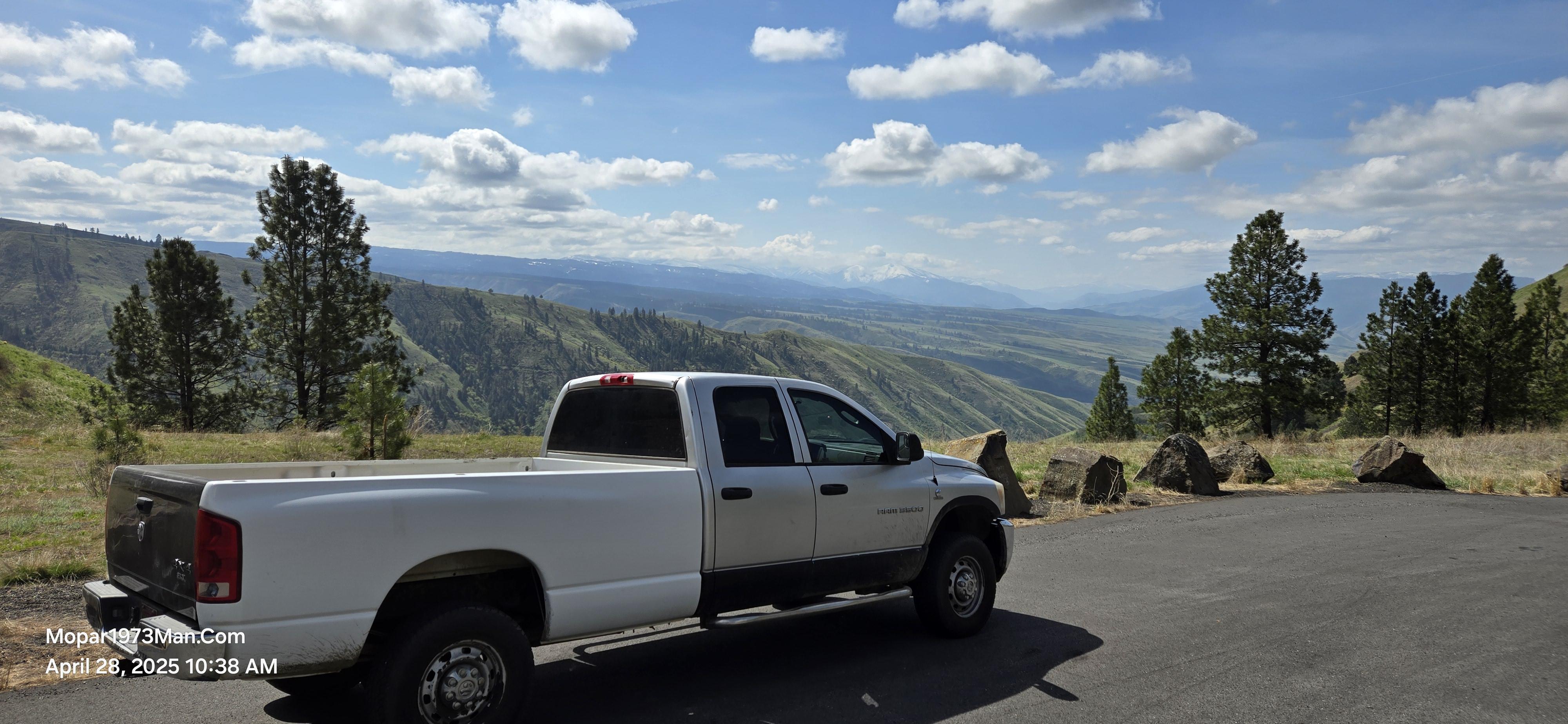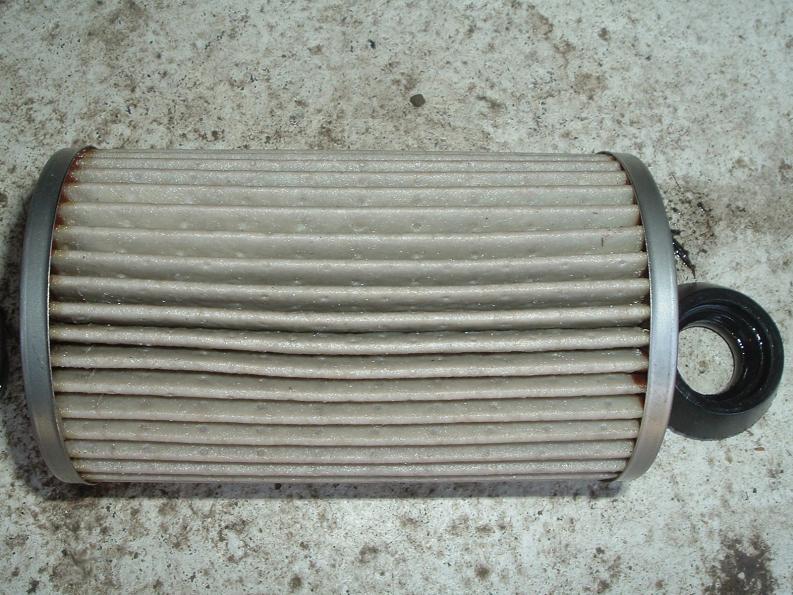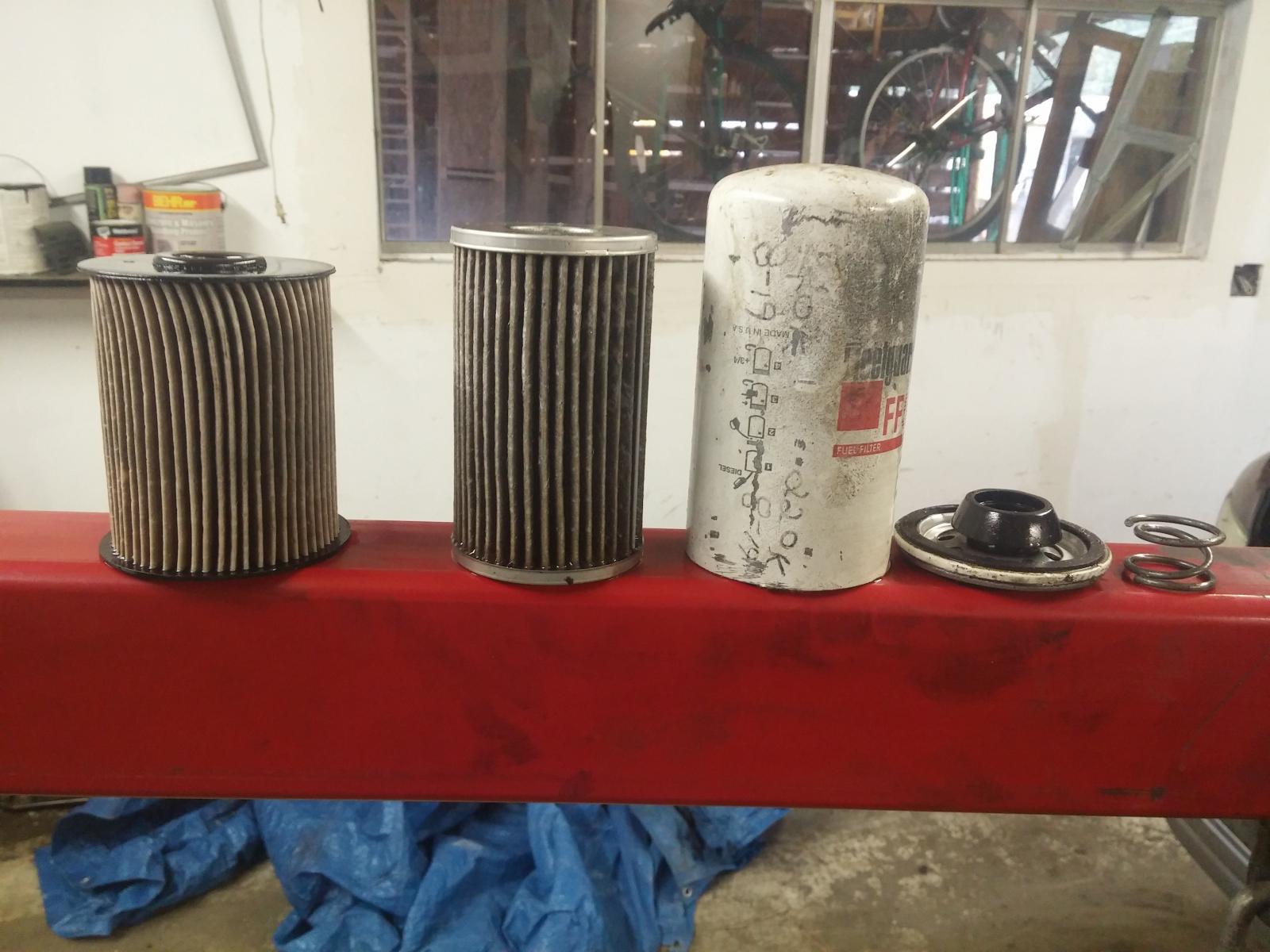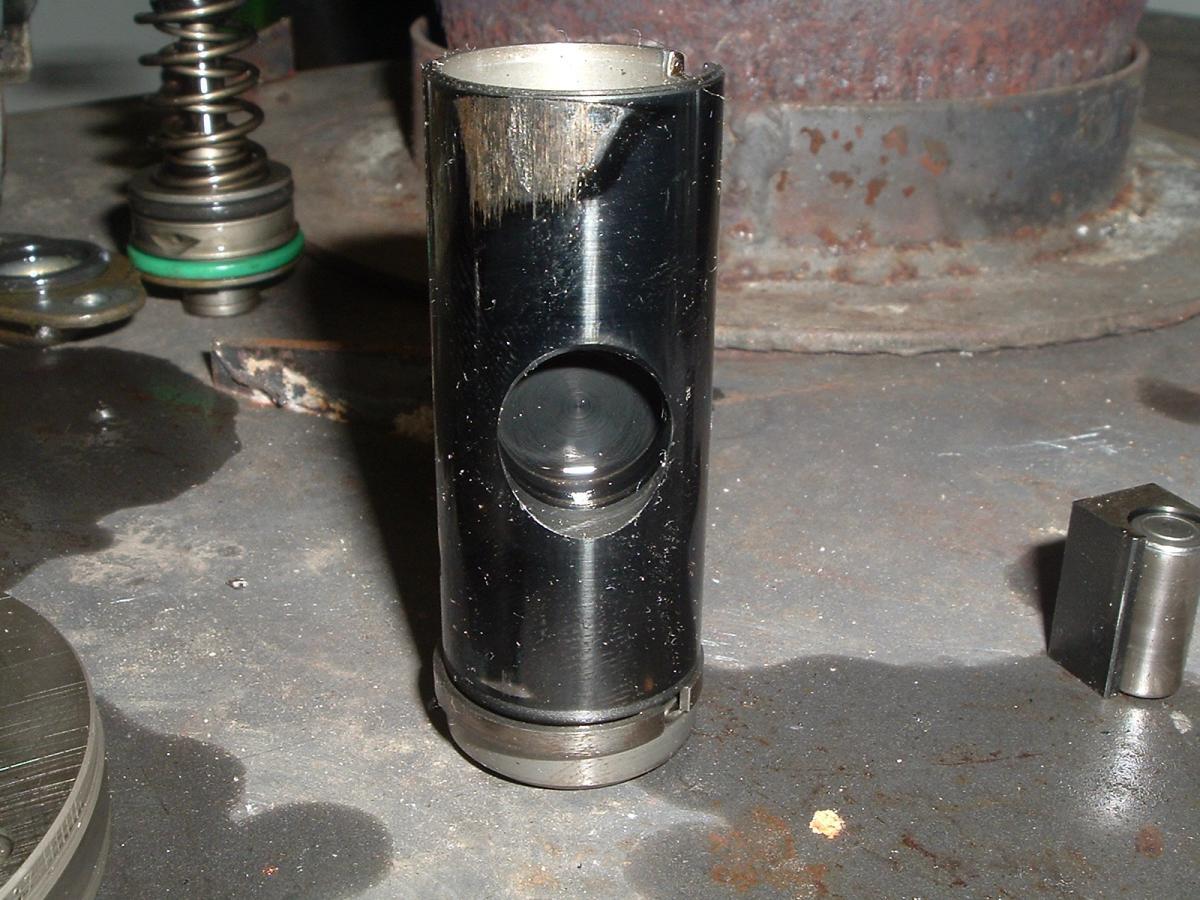
Mopar1973Man
Owner
-
Joined
-
Last visited
-
Currently
Viewing Topic: Front driver's seat removal
Everything posted by Mopar1973Man
-
Lift Kits and Oversized Tires - What you need to know before you start!
Before your add a Leveling Kit or Lift Kit and Larger Wheels and Tires First off I want to start with how to get correct final ratios. Remember that for most trucks was a 265/75 R16 tire... Like my truck came with 265/75 R16 tires even though the door sticker states 245/75 R16. The 245/75 R16 was used in the early 24V body design. The most common axle is 3.55 gears. If you are going to use a larger than stock tire makes sure to have 4.10 gears. Its a REQUIREMENT! Final Ratio Goals Optimal Goal Let me just state you aiming for a final ratio of 3.55 to 3.73 which is the most optimal for power and economy. Let's just show how just a small jump from 265's to 285/75 R16 turns the final ratio. This will now create a final ratio of 3.42:1 which is a marginal you could use it but optimally it will add more EGT's and higher engine loads. The more you keep increasing the tire size it will drop the final ratio too low. For example, going from 265/75 R16 to 37 x 12.50 R16 you are now at 3.04 for the final ratio. Again you cannot install large tires on a 3.55 geared axle. This combination is going to create super high EGT's and high engine loads so the power is greatly reduced and the EGT's will sore well past 1,200*F. Another wanting to run oversized tires should consider installing 4.10 gear for everything up to 37-inch tires. This again impacts even tuning with the Quadzilla being you are going to require a large drop in timing more retard timings just so the turbo will spool quicker. The tool I use to find the final ratio to the ground. https://tiresize.com/gear-ratio-calculator/ Me personally, I ditched the 265/65 R16 and opted for the 245/75 R16 being that gives a final ratio of 3.69.1. Cruising at 66 MPH is just about dead money at 2,000 RPM. At 82 MPH you are at 2,500 RPMs. This is a good ratio. I've gotten many trips to Boise down the I84 interstate at 80 MPH and cleared 20 MPG commonly. I'm also NV4500 transmission (0.75:1) where a 47RE transmission is lower yet at (0.69:1) these should be a touch lower in RPM. The NV5600 is close to the NV4500 at (0.73:1). Geometry Now a lot of people don't know but just adding a 1-inch lift to a 2nd Gen truck will screw all the angles up in the axle. Even the 2-inch lift will do it even worse. The problem is the axle is swung on 4 control arms. When you add lift to the axle you are swinging the axle downwards as it swings down more the control arms are fixed and the axle rolls forward more which now makes for a more neutral caster angle. This could be corrected by install adjustable control arms on the bottom this would allow you to recover most of the caster angle. Then as you lift or level the front axle the track bar is a fixed length since its farther from the frame the track bar will pull the axle to the left side some this now enhances the thrust angle to the left. Between these two angles, you now created a truck that has poor centering on the highway and darts. Then the thrust angle is off it will tend to pull left. You could install an adjustable track bar to correct the thrust angle. Wide wheels tend to place a lot of stress on the wheel bearings and ball joint being most have quite a bit of offset having the wheel poking out of the wheel well. Being you've added a long lever to pry against the bearings and the ball joints. In any case, you are going to add a lot of load on the steering box. I recommend using the standard ratio steering box. This is a lower gear ratio steering box and makes it easier for the box to steer those wide tires and reduce stress. I highly recommend that you find a good alignment shop that does not work out of a book someone that understands the lifted truck and the needed angle changes to make a stable ride. Acceleration The larger your wheels and tires, the more mass you have in the wheels the more it will take to get the axles rolling. The rule of thumb is for every 1 pound of rotational mas you remove is like 8 pounds off the frame. To show this you might remember the park where those big merry go rounds.  Like this one, you could get about 2 or 3 kids to pull it around. Bigger the Merry go round got the more kids you needed to get it up to speed. Maybe even a few adults to help out. The point is the more mass in any rotational part is going to take even more power or energy to get it spinning and even more to hold the speed up. I've studied this on many trucks and driven plenty of oversized trucks too. No matter what larger tires do come at a cost of loss of power and lowered MPGs. The only way to make it better is to ditch the weight. which most after spending a small fortune outfitting with new wheels and tires. Hence why this article is to warn most of what you coming into. Being this weighed load is there you find that EGT's are going to be higher and the engine loads to maintain speed are higher. Example of this in real life. I went to a dyno event with my truck back in 2006. All I had was stock injectors and Edge Comp. I was green to the whole dyno event but rush to get in line to run the rollers. One I ran the rollers I had 381/831 on my dyno sheet. Now my buddy with a 96 Dodge 12V jump in and ran the rollers came up just short 362/825. I gave him a big load of crap over it. He requested to get off the rollers after his first run. He pulled out in the lot and pull the outer two dual tires off and got back up on the rollers grinning. I didn't know why. Now I know why after shedding the rotational mass of the outer dual wheels and ran on the inners alone and surpassed me in power. He had a net gain of about 28 HP gain which gave him the win at 390 HP. Another example at the same dyno shop different events. I have seen a jacked-up Ford on the rollers and barely made 260 HP with 37-inch tires. Then he rolled off the rollers and took off the 37-inch tires and put on stock 31-inch tires and well in the 400 HP range. Again larger tires do limit the power to the ground. Looks cool but steals the power from getting to the ground. Achievements As for my own truck I never used any leveling kits or lift kits its complete stock. I've changed only one set of ball joints at 180k miles. I bought some cheap ball joints off of RockAuto years ago and now over 250k miles and still running those ball joints. OEM Tie Rod Ends lasted for 350k miles and was replaced only once. As for the track bar, I'll admit will all the offroad driving I manage to typically wear them out at about 100 to 150k miles for a NAPA track bar. I've replaced a few. Brakes wise I go upwards of 200k miles for a set of brake shoes. Yes, I have an exhaust brake and use it every day. With running the optimal ratio that I am I shaved off at least... At least -100°F in EGT temperature. At least -30°F in transmission temperature. At least 5% engine load reduction. At least +2 to +3 MPG gain. Most suspernsion parts lasting 200k miles. Lower Differential temperatures. More power produced at lower RPMs. Never had a single case of death wobble, never had any tracking issues or sloppy steering. I'm currently at 421k miles at the time of this article.
-
Engine Oil Leak
Serious enough to blow just about 2 quarts in just a week of driving after my oil change. Crank tip has the standard dust seal groove in the tip. I'm not worried much. When I install the new crank seal I just move inward a bit more. Lot of room. I've had a slow weeping leak for quite some time so this will be nice to get fixed. I want to snug up the gear case on the block side. If I can get those Allen screw snugged up will be awesome. I even checked the timing of the gears. Yup. All in time yet. Four bolts... 3 are behind the cam gear.
-
Engine Oil Leak
Ok... Pull the gear case front off being I want to check the bolt along the block edge to tighten. Still can't see all them but the top on for the KDP pin. But... I might of dove in too quick. Crawled back under and trying to source out where the oil is leaking from. Reached up with a 15mm wrench to pull the vacuum pump bolt and found it loose. Since I'm here I'll re-do my vacuum pump seal and crank seal.
-
Need truck to be running better, less smoke
This is the one I use commonly... use the 265/75 R16 for stock and fill in the new tire and stock axle ratio.
-
Need truck to be running better, less smoke
I've gotta get some free time where my thought are fresh and create it. This is a super common issue.
-
Need truck to be running better, less smoke
Final ratio is way too low with 3.55 axles like 3.27 roughly. You need to consider swapping to 4.10 gear in front and rear. This will get you back to a good final ratio and reduce a ton of smoke and EGTs. As you go bigger the ratio ALWAYS goes down. Smaller tires make the final ratio go up. Another problem is the geometry of the front axles are typically not right after a adding tires and lift kit. When you lift the axle actually your pushing it down farther.Now the caster angle is more neutral and the thrust angle is to the left more being neither the control arms are too short and the track bar to get anlges correct. Then Rotational mass is the next. For every one pound of rotational mass you ditch is like 8 pounds off the frame. So for every one pound of wheels and tire mass is like adding 8 pounds on the frame. Might look cool but add up in working loads. Just be aware...
-
2001 Auto Upgrade Plans - Turbo, Injectors, Quadzilla, Gauges
Absolutely... As for what @Dynamic did for my lil' 1996 Dodge 1500. He upgraded it to a 47RE. Basically single disc torque converter. Then shaved a 0.1 of inch off the clutch baskets and added an extra disc to both direct and overdrive clutches. Then upgraded governor pressure sensor and solenoid. Custom shift kit where he modified my valve body by drilling out certain holes to different sizes. Then added two holes in the body of the transmission inside on the return line and spraying cooled oil on both clutches so they stay cool. These are mods you never find in a kit but @Dynamicproves this service. As for gauges I would recommend the ISSPro EV2 electric sender gauges. They are USB programmable and you can adjust the warning light on setting, you can program a relay to turn on or off different things devices if wanted (Trans temp turn on a aux fan). Very solid design of gauge and matches the Dodge 2nd gen cluster.
-
Engine Oil Leak
Could I ask a huge favor from someone. I would like a picture of the inside of the gear case and where all the bolts are without the cam and pump gear in the way. My oil leak is on the rear side of the gear case and running down to the corner of the pan and blowing back. I'm looking at options to tighten all the bolts and see though. Or loosening all the bolts and separate a little and get a small bead of silicone behind the edge. Either way it leaking engine oil pretty good in 15 miles its got oil splattered all the way to the transfer case.
-
Blend Door Coupler
I will add that I've done many of these now. Seriously it way easier to do it in a full removed HVAC and best to do it them without all the troubles of working in tight quarters between the transmission hump and the HVAC case. Make sure you reindex the gears inside the stepper motor. If not it creates all kind of weirdness too.
- 2 comments
- 2 reviews
-
-

- 1
-
-
2001 Auto Upgrade Plans - Turbo, Injectors, Quadzilla, Gauges
I'm Close to @Me78569 specs above... Quadzilla Adrenaline (Mopar1973Man Towing Tune) DAP 150 HP injectors ( 7 x 0.010 @ 320 bar) HX35/40 Hybrid (60/60/12) the HE351 above is a (60/60/9) 4 Inch Exhaust unmuffled BHAF AirDog 150 (w/ AirDog 165 4G pump) 245/75 R16 tires (final ratio to the ground 3.69:1) Ran all the way to Arizona this summer with the RV weighed out at 17,300 pounds GCW. Made 14.7 MPG even with a climb to 7,000 feet in Nevada. Never had any EGT's issues at all hovered at 1,1000 to 1,200*F and coolant stayed in check. The only difference is I'm more closer to 500 HP. Last summer I had enough power to blew the teeth off 5th gear in a NV4500. Never mind the 5th gear nut problem I just take the teeth off.
-
Need truck to be running better, less smoke
Agreed. Stock turbo HX35w is a 54/60/12. I'm only running a HX35/40 hybrid (60/60/12) with 150 HP injectors. I make more than enough power to tear the tires off the rear of my truck even in 4th gear (NV4500). The biggest factor is having the proper timing over the entire span of fuel map. I would of opted away from the hotrod pump. Adds extra challenge to timing being the hotrod pump tend to start out advanced. Been best with a standard SO pump and used a turner. SO pump can fuel way past 600 HP. Several have done it. Kind of like my high popped injectors requires more timing. Added challenges of tuning proper. Kind of like my mod of going to 150 HP injectors but not popped at 305 bar like most (remember stock is 310 bar) I popped at 320 bar. This cleaned up a huge amount of smoke and EGT's are very controllable. Even hauling my RV up to 7,000 heading to Arizona I never had any smoke or EGT's issues and came in with 14.7 MPG on that trip. Dodge Spec on pop pressures from the Dodge FSM (293 bar low limit, 310 bar stock, 327 bar upper limit) Anything below 260-270 bar is a loss typically idle speed starts to rise and ECM is typically close or already fully defueled at idle. Quadzilla Adrenaline HX35/40 Turbo 4 inch exhaust AirDog 150 (w/ AirDog 165 4G pump) BHAF DAP 150 HP injectors (popped at 320 bar) 245/75 R16 tires (30.5" inch tires) to raise my final ratio. (3.69:1 after tires). Even 4th and 5th gen truck have troubles catching me. Like posted above made enough power to break the teeth off 5th gear. You be surprised what even 150's will do with proper tuning. The biggest thing that destroys the power. Is lifts and oversized tires. This typically lowers the final ratio and increases the loading on the driveline. When your final ratio after tires falls below 3.40 you just lost huge amounts of power. Does nothing for MPG's too. Optimal final ratio after everything should be 3.55 to 3.73 to the ground. This combo really does reduce the smoke a bunch, EGT's are much lower, Engine loads are lower and MPG's are higher. Give you an idea at 66 MPH I'm at perfect 2,000 RPM. Right in the middle of the power band and just drop my foot and she is off to the races.
-
In this episode of WTF is wrong.. - Fuel Pressure
AirDog or FASS is a complete kit. Then mechanical pump that are belt driven the only thing I don't like is there is no priming pump. Kind of like yesterday I forgot to take my line clamp off and the truck ran out of fuel and died. Bump the starter a couple of times prime it up and start fairly easy. But mechanical pump will not be able to do this. You'll have to use a drill and pull the pump and belt and spin the pump to get the system primed. Also make sure to KEEP the stock filter. Like myself I change filters at 60k to 70k miles now. 15k is a waste being the filter still look brand new. The factory can filter is a 7um filter and it catching more that the 3um Donaldson is passing. I just changed my fuel filter and going to cut it open later today. Being my fuel temps are much lower I don't get the large amount asphaltene like people with lower fuel pressure so my fuel filter stay cleaner longer than most. 15k mile Fleetguard 3um filter. (AirDog 150 filter) 60k miles on both... (Stock can filter 7um, and fleetguard 3um AirDog 150 filter)
-
In this episode of WTF is wrong.. - Fuel Pressure
If you get it to resolve the P0216 code and stay cleared after a tank of fuel I would still watch it like a hawk. Kind of like saying if the oil pressure minimum is 10 PSI at idle and the engine oil pressure is actually 8 PSI at idle and barely 25 PSI at 2,000 RPM. Do you expect the engine to last as long? Most likely not. Being the fuel is your lubricant and coolant for the VP44 when you short change for pressure now your return is closed being the over flow closes at 10 PSI completely this means all your cooling and lubing ability of the fuel has stopped. Now this goes farther being now the cooling has slowed way down now the fuel temperature rises (Flow is roughly 2.5 GPH at 55 MPH). I've had a discussion with some that have 140 to 150*F fuel temps. While with my setup I struggle to even reach 130*F. Typically more like 90 to 110*F fuel temps. VP44 PSG is very happy here. Being the fuel pressure never drop below 14 PSI this means optimal cooling and lubing. Meaning longer life. Yeah you can run a VP44 on as little as 5 PSI as BlueChip so quickly announced you can still make MAX HP. But I'll note the longevity is greatly shorten on the VP44 from the lack of cooling and lubing.
-
In this episode of WTF is wrong.. - Fuel Pressure
Because the OE lift pump was too small from the start, why most of us upgrade to larger pumps. If pressure is dropping out then the pump is too small and the plumbing is too restrictive. I was here a very long time ago with the very same problem where I ran Carter Campaign pump on the frame rail and fought to barely reach 11 to 12 PSI at WOT and 14 -15 Cruise pressure. Still to this day I still see stock fuel system barely pulling 5 to 7 PSI at WOT and just shake my head. Doesn't even need to be modified to be be low in pressure hence the whole reason for lift pump market for our truck it never went away. Might have too though... If the timing piston is galled up and stuck there is absolutely nothing you can do. I just done a VP44 that would start cold and run fine but shut it down it would never start again with a warm engine. P0216 code present and the timing piston is STUCK ADVANCED so the engine will never start. After a new VP44 truck run great and starting issues is over. If you can't get proper timing there is a host of weird things that pop up from not starting or just running will super low power. Even my last VP44 was stuck full advanced and was rattling hard core. P0216 code and only could do about 25 to 30 MPH top speed home. To remove this piston I had to heat the pump body with a propane torch and expand the body to even pull it out. Additional info... Yes I've already been done this road long time ago...
-
In this episode of WTF is wrong.. - Fuel Pressure
Demand volume is out weighing the supplied volume. Need a pum with more volume to keep up. Then you need plumbing with less restriction. Stock lift pumps are about 60 GPH pump which are too small from the get go. The stock plumbing is less that 1/4" its 6mm ID. Very restrictive. Even to this day AirDog 150 pump I'm only a 2 to 3 PSI drop from idle to WOT at 100 MPH with about 500 HP with of mods. This just points out you need a better fuel system. Make sure the tank vent is not plugged up you could clean it up and the route some vinyl tube to a higher place where mud and dirt won't plug it. VP44 is done and need to be replaced with that P0216 code the timing piston is ruined. Quadzilla Adrenaline 180 HP DAP 150 HP Injectors (7 x 0.010 @ 320 bar) HX35/40 Hybrid Turbo 60/60/12 producing 47 to 49 PSI boost. AirDog 150 with a 4G AirDog 165 pump. Idle at 17 PSI and WOT at 14 to 15 PSI @ 100 MPH.
-
All sorts of problems w/quad download
PSG is the electronic module controlling the vp44. Fuel pressure during cranking should be 7 to 12 bouncing. This is normal being the ECM is 50% duty cycle on the lift pump. Use a shop vacuum on blow and pressurize the fuel tank and have a second person look over the suction lines. Crossover tubes have o-ring seals and might weep air back in. Overflow valve can be tested by using compressed air set to 10 PSI the valve should stay closed. Then at 14 PSI it should be open. Disregard the bleed hole it doesn't count.
-
All sorts of problems w/quad download
Typically hot start issue is high cranking fuel pressure and/or possibly P0216 code. Like the last one I dealt with you could start the engine cold but after it warmed up it would not start again. It had a P0216 code. After VP44 replacement the hard start was gone. This was cause by a stuck timing piston and it was stuck advanced. Needless to say that job managed to down me for one month while my left hand ring finger healed up. Yup. Trying to get the pump gear off with my puller and punched the fan. Should of had stitches but I dealt with it myself being I didn't want to deal with the BS COVID-19 test and hospital policies.
-
All sorts of problems w/quad download
Quad has nothing to do with start up. It ignored at start up. Watch your fuel pressure gauge if you have a mechanical gauge. If the gauge falls out there is a air bubble going up the line. Air is compressible so the pressure typically sinks for a bit and pops back up. Check suction lines they typically will not leak out but continue to suck air in.
-
Fuel mileage with new injectors
- NV5600 Fluid, Fast Coolers, Filter
Impressive...- NV5600 Fluid, Fast Coolers, Filter
Funny part is the biggest problem is thin fluids. PenzOil is so thin its like 5W or even 0W engine oil hence why the failures. There is no way to make that oil cling to gears or bearings if the oil is slung off with centrifugal forces. One of the few reason I stepped up to thicker lube. Stock NV4500 was 75w-80 when I swapped to Mobil 50 SAE that turns out like 90 weight gear. But being single grade it nearly the same as 80 weight side of the factory fluid you can look up the centistokes at temperature viscosity of both and see it nearly the same.- NV5600 Fluid, Fast Coolers, Filter
Exactly... Shouldn't overfill...- 01 Rough Idle Then Smooth with No Tach
Check the wiring it could be wiring issues. Then its possible the tone ring fell off into the pan ive seen one case of this. Poor quality sensor possible.- Install guide for kill switch on 2nd gen cummins
My design... above... hmmm I wonder who let the cat out...- Oil in water again
Yeah after all the miles on mine at 350k miles I opted to just upgrade to 425 ARP studs and be done. - NV5600 Fluid, Fast Coolers, Filter







